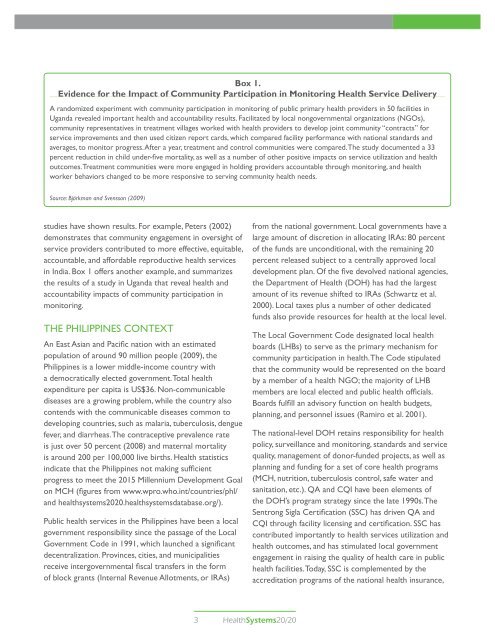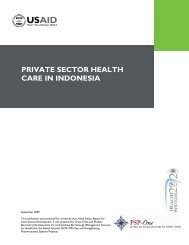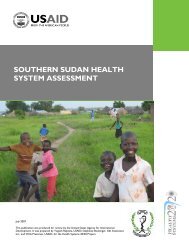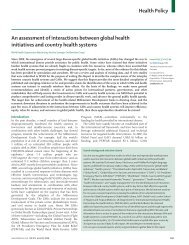Community engagement in facility-based quality improvement in
Community engagement in facility-based quality improvement in
Community engagement in facility-based quality improvement in
Create successful ePaper yourself
Turn your PDF publications into a flip-book with our unique Google optimized e-Paper software.
Box 1.Evidence for the Impact of <strong>Community</strong> Participation <strong>in</strong> Monitor<strong>in</strong>g Health Service DeliveryA randomized experiment with community participation <strong>in</strong> monitor<strong>in</strong>g of public primary health providers <strong>in</strong> 50 facilities <strong>in</strong>Uganda revealed important health and accountability results. Facilitated by local nongovernmental organizations (NGOs),community representatives <strong>in</strong> treatment villages worked with health providers to develop jo<strong>in</strong>t community “contracts” forservice <strong>improvement</strong>s and then used citizen report cards, which compared <strong>facility</strong> performance with national standards andaverages, to monitor progress. After a year, treatment and control communities were compared. The study documented a 33percent reduction <strong>in</strong> child under-five mortality, as well as a number of other positive impacts on service utilization and healthoutcomes. Treatment communities were more engaged <strong>in</strong> hold<strong>in</strong>g providers accountable through monitor<strong>in</strong>g, and healthworker behaviors changed to be more responsive to serv<strong>in</strong>g community health needs.Source: Björkman and Svensson (2009)studies have shown results. For example, Peters (2002)demonstrates that community <strong>engagement</strong> <strong>in</strong> oversight ofservice providers contributed to more effective, equitable,accountable, and affordable reproductive health services<strong>in</strong> India. Box 1 offers another example, and summarizesthe results of a study <strong>in</strong> Uganda that reveal health andaccountability impacts of community participation <strong>in</strong>monitor<strong>in</strong>g.The Philipp<strong>in</strong>es contextAn East Asian and Pacific nation with an estimatedpopulation of around 90 million people (2009), thePhilipp<strong>in</strong>es is a lower middle-<strong>in</strong>come country witha democratically elected government. Total healthexpenditure per capita is US$36. Non-communicablediseases are a grow<strong>in</strong>g problem, while the country alsocontends with the communicable diseases common todevelop<strong>in</strong>g countries, such as malaria, tuberculosis, denguefever, and diarrheas. The contraceptive prevalence rateis just over 50 percent (2008) and maternal mortalityis around 200 per 100,000 live births. Health statistics<strong>in</strong>dicate that the Philipp<strong>in</strong>es not mak<strong>in</strong>g sufficientprogress to meet the 2015 Millennium Development Goalon MCH (figures from www.wpro.who.<strong>in</strong>t/countries/phl/and healthsystems2020.healthsystemsdatabase.org/).Public health services <strong>in</strong> the Philipp<strong>in</strong>es have been a localgovernment responsibility s<strong>in</strong>ce the passage of the LocalGovernment Code <strong>in</strong> 1991, which launched a significantdecentralization. Prov<strong>in</strong>ces, cities, and municipalitiesreceive <strong>in</strong>tergovernmental fiscal transfers <strong>in</strong> the formof block grants (Internal Revenue Allotments, or IRAs)from the national government. Local governments have alarge amount of discretion <strong>in</strong> allocat<strong>in</strong>g IRAs: 80 percentof the funds are unconditional, with the rema<strong>in</strong><strong>in</strong>g 20percent released subject to a centrally approved localdevelopment plan. Of the five devolved national agencies,the Department of Health (DOH) has had the largestamount of its revenue shifted to IRAs (Schwartz et al.2000). Local taxes plus a number of other dedicatedfunds also provide resources for health at the local level.The Local Government Code designated local healthboards (LHBs) to serve as the primary mechanism forcommunity participation <strong>in</strong> health. The Code stipulatedthat the community would be represented on the boardby a member of a health NGO; the majority of LHBmembers are local elected and public health officials.Boards fulfill an advisory function on health budgets,plann<strong>in</strong>g, and personnel issues (Ramiro et al. 2001).The national-level DOH reta<strong>in</strong>s responsibility for healthpolicy, surveillance and monitor<strong>in</strong>g, standards and service<strong>quality</strong>, management of donor-funded projects, as well asplann<strong>in</strong>g and fund<strong>in</strong>g for a set of core health programs(MCH, nutrition, tuberculosis control, safe water andsanitation, etc.). QA and CQI have been elements ofthe DOH’s program strategy s<strong>in</strong>ce the late 1990s. TheSentrong Sigla Certification (SSC) has driven QA andCQI through <strong>facility</strong> licens<strong>in</strong>g and certification. SSC hascontributed importantly to health services utilization andhealth outcomes, and has stimulated local government<strong>engagement</strong> <strong>in</strong> rais<strong>in</strong>g the <strong>quality</strong> of health care <strong>in</strong> publichealth facilities. Today, SSC is complemented by theaccreditation programs of the national health <strong>in</strong>surance,3 HealthSystems20/20
















